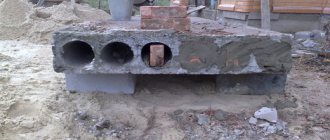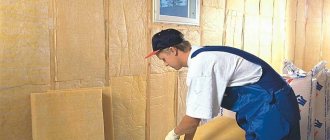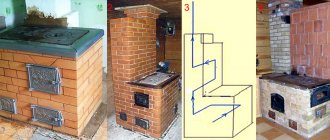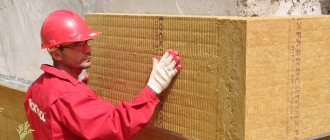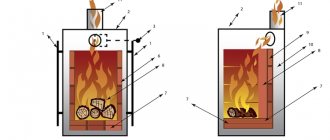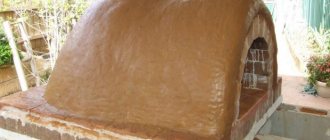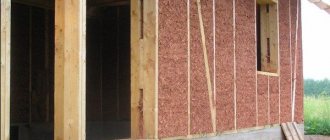Today there are no particular problems with the choice of thermal insulation materials. At the same time, sawdust as an insulation material still does not lose its relevance. If there is a wood processing plant nearby, the raw materials will be much cheaper. Therefore, when the task is to insulate a house and do it at the lowest cost, it is worth thinking about such a useful insulation material as sawdust.
Characteristics of sawdust insulation
Insulating structures or blocks made from sawdust have the following features:
- The insulation has high vapor permeability. The walls of the building breathe, condensation does not form inside the premises. Therefore, the occurrence of fungi and mold inside the building is minimized. In such houses, the indoor humidity remains the same regardless of the time of year.
- The thermal conductivity of sawdust is lower than that of modern insulation materials. But by increasing the thickness of the layer, heat loss can be reduced to a minimum. Additionally, the insulation has excellent soundproofing properties.
- This material, even compared to other insulation materials, lasts quite a long time. Wood waste is not destroyed under the influence of external factors. There are houses built 150 years ago, the sawdust layer of which is still in excellent condition.
These characteristics show that sawdust insulation is no worse than modern heat insulators. If installation work on thermal insulation of a house is carried out correctly, to some extent they even surpass them.
Sawdust and shaving waste from furniture factories cannot be used as insulation. The raw materials left over from sawing plywood are oversaturated with toxic substances; the thermal conductivity of waste plywood is quite high.
House made of sawdust
In addition to insulation, sawdust is used for the full construction of buildings. However, buildings made of sawdust concrete are rare today. However, experts assure that sawdust concrete is a very promising material that allows you to build economical housing with decent performance indicators.
The manufacturing technology of such material involves the addition of binding components, for example, clay, lime, liquid glass. These additives reduce shrinkage phenomena and reduce the cost of modules. By adjusting the proportions of individual components in relation to the total weight, it is possible to change the density, porosity and strength of the final product.
Practice shows that optimal protection is achieved after lining, however, for example, a sawdust bath can be used without finishing.
The advantages of sawdust concrete include:
- thermal conductivity 0.20-0.30 W/m°C. A wall 40.00 cm thick is similar in warmth to a 90 cm brick wall
- strength 20.0-50.0 kg/cm². This material perfectly resists deformation and shock loads, so it can be used for construction in areas with probable seismic activity
- easy processing. Modules can be milled, nailed, drilled, processed with a hacksaw and saw. Consequently, material consumption is reduced and there is almost no waste
- shrinkage 0.50 – 1.00%mm/m
- frost resistance – 25 cycles
- density 300-1200 kg/m³.
Among the shortcomings we note:
- moisture absorption. This disadvantage can be combated by treating the blocks with special compounds.
- impossibility of constructing multi-storey buildings
- not very attractive appearance without finishing.
Insulation with sawdust: pros and cons
Every year more and more new generation insulation materials appear on sale. The biggest drawback of such high-tech products is the cost of thermal insulation material. At the same time, it is unknown how they will behave in a couple of decades. Therefore, the old ancient method - using sawdust as insulation - remains relevant to this day.
The main advantages of chip insulation are:
- environmental friendliness. The raw materials are completely harmless to a person living in a building insulated with wood waste. Since the insulation does not emit any toxic substances. Therefore, even allergy sufferers feel comfortable in such houses;
- low cost. If there is a sawmill or any woodworking enterprise nearby, you can obtain production waste completely free of charge. Costs will be spent only on cargo transportation;
- reliability. This has already been mentioned above, but the durability of insulation made from wood chips is its undoubted advantage. Nowadays various antiseptics are added, which help protect the insulating layer from insects, thereby extending the life of the insulation;
- versatility. Raw materials can be used to insulate the entire structure - from the floors to the roof. The installation process is simple, so you can do it yourself. Due to the fact that sawdust has a fine fraction, raw materials can be poured into even the most inaccessible places without the use of special devices and tools.
The material has few disadvantages, but it is often because of them that many refuse to use sawdust as insulation:
- wood waste has a high flammability class. That’s why today they are increasingly being mixed with non-flammable substances and additionally treated with fire retardants;
- the use of loose wood particles leads to rodents and insects settling in the “fills”. Those who have encountered a similar situation are recommended to add tobacco or slaked lime to the insulation;
- If you use only sawdust as thermal protection for households, over time they will cake and voids will form. Therefore, special binding components are added that eliminate this drawback.
Having considered all the pros and cons of the material, we can conclude that sawdust-based thermal insulation is an excellent alternative to many modern insulation materials.
We turn sawdust into insulation: how it’s done
The work begins with the preparation of a heat-insulating mixture. In order for this mixture to be of sufficient quality, it should be prepared from the following ingredients and in the following proportions:
- 1 bucket of water with antiseptic added to it;
- 10 buckets of sawdust;
- 1 bucket of cement;
- 1 bucket of lime.
When preparing the insulating mixture, you need to carefully monitor the moisture content of the mass, which largely depends on the moisture content of the main component - sawdust mixed with shavings. If necessary, water should be added using a watering can.
How can you tell whether the consistency of the insulation being prepared is correct? This is quite easy to do. You just need to take a handful of the mixture in your hand and squeeze it. If the lump does not crumble, then the proportions of the components are chosen correctly.
When the insulation is ready, they should carefully fill the cavities of the walls of the frame house.
Please note that sawdust can be used as insulation only if the walls of the frame house have a sufficient level of vapor permeability, since the sawdust mass requires a constant flow of air. Therefore, walls cannot be covered with roofing felt, polyethylene or roofing felt, that is, materials that interfere with the circulation of air masses.
Binding components
The choice of the optimal binder is made taking into account what component is available and what characteristics it has. The most commonly used materials are:
- Gypsum. The solution sets quickly, so it is often used as a binder. Within 10 minutes, the mixture of sawdust and gypsum hardens, and after a couple of hours it dries completely. The resulting insulation is durable and lightweight. The so-called bridges of cold and all kinds of voids do not appear in it. But if this mixture is used to insulate an external wall, then it is additionally required to cover it. Moisture will contribute to the destruction of thermal insulation from a solution of sawdust and gypsum. This type of insulation is more suitable for internal thermal insulation of buildings.
- Cement. This component is more durable, but more difficult to work with. Sawdust and cement mortar set within 24 hours. This solution is often used for plastering the outside of the house. After the binder component hardens, even water flowing down the walls will not be able to destroy the sawdust-cement layer. The solution is also used to fill ceilings, interior and underground spaces. Cement is gray in color, but it can always be diluted with color and then there is no need to additionally apply decorative plaster to the surface.
- Clay. This is one of the cheapest binder components. But there is a significant drawback: the mixture is completely unstable to humidity. After drying, the solution significantly loses weight as water evaporates. Such insulation is in no way inferior in strength to cement-sawdust (gypsum-sawdust) thermal insulation.
- PVA glue. This component is used as a binder for the further use of insulation in places where frequent exposure to moisture occurs. The glue reliably grips the sawdust, resulting in a durable, hard layer that is not subject to corrosion and rotting. Its strength does not decrease over time, and polyvinyl acetate (hardened adhesive) has excellent steam permeability.
- Manure. A long-forgotten component as a binder, but previously it was used to insulate households. The strength of manure is not as high as that of other binders, but after drying, the manure solution forms a crust that has a porous structure. Therefore, such a thermal insulation layer has excellent thermal conductivity parameters. But it is additionally required to cover it with cement or gypsum mortar or cover it with boards.
- Lime. This component allows you to obtain a durable thermal insulation layer. The mass of sawdust with lime becomes more dense in consistency. This allows you to obtain insulation that will not deform over time. Heat loss is significantly reduced, and rodents in such thermal insulation do not make moves or make nests inside.
The solution is also used for the production of slabs, mats, and sawdust blocks. Their thermal insulation properties are no worse than mineral wool. To make them, they use special molds that you make yourself.
Ceiling insulation with sawdust
It is necessary to insulate the ceiling in a private house from any material, both brick and foam blocks. Because it is through the ceiling that significant heat loss occurs. Average heat loss through the ceiling is 20%. From an economic point of view, the most profitable is insulating the ceiling with sawdust.
Please note that laying wood products is a labor-intensive task. Before installation begins, a lot of preparatory work needs to be done. First of all, such work is aimed at protecting against fire, because wood in any form is extremely flammable. It is highly flammable and has a long burning time.
What materials and tools may be needed:
- sawdust of small and large fractions
- sand, clay or slag
- lime and copper sulfate (you can take boric acid)
- substrate. For this purpose, you can use corrugated cardboard or any other breathable materials with good vapor permeability.
- sealant and foam
- fire retardant and antiseptic for wood. These compounds are necessary if the ceiling boards are not covered with protective material against mold and mildew, fire
- construction stapler and staples for it.
Work should begin with protecting the ceiling beams and boards from possible adverse factors. Most often, high-quality buildings are already built from processed timber. However, if this procedure was missed for some reason, then it is imperative to carry it out now.
Wooden elements must be protected comprehensively, and the following sequence must be observed:
- An antiseptic is applied first, which prevents rot and protects against insects
- Next come fire-bioprotective agents that increase resistance to fire and high temperatures.
- Still others use water repellents to prevent moisture from entering the wood structure. In addition, such products protect the wood from leaching of previously applied solutions.
To achieve higher efficiency, it is worth purchasing all drugs from the same manufacturer.
After carrying out the protective work, you need to seal all seams and joints with foam and sealant. In addition to the cracks in the ceiling, you need to seal any other holes that may be present in the roof structure. This is necessary so that the insulating material does not come into contact with precipitation or strong winds, which can lift the insulating layer. Do not forget to trim the protruding parts of the foam at the same level as the ceiling beams, otherwise there will be voids in these places through which heat will escape.
Next, you can lay a backing, which is needed to prevent small dust from sawdust from falling off the ceiling. This dust can become a source of additional dust in the house. The substrate must have vapor-permeable qualities. If there are no such qualities, then warm air and steam, rising upward, will remain between the boards and materials, and will cause additional condensation. As a result, mold may form due to excessive humidity. As a backing, you can use any cardboard, for example, from old packaging boxes. The main thing is that it must be completely dry.
Clean the ceiling boards from dirt and dust and place cardboard sheets on them in several layers. Lay the underlay overlapping by 15-30 cm to prevent sawdust from getting into the seams. Now you will need a stapler, with which you need to fasten all the joints of the material.
Sawdust should be purchased dry, without foreign odors. They should be treated in advance with fire retardant and antiseptic compounds. After the mass has dried, you can add 10% lime (fluff) and a small amount of copper sulfate (or borax). All this needs to be mixed well.
There are several basic methods for installing thermal insulation from sawdust. They can be poured dry or mixed with cement and diluted with water. Sawdust can be poured either in pure dry form or mixed with cement and diluted with water.
With the dry method, sawdust is poured in two layers:
- large fraction or shavings. This layer should be 10-15 cm thick. It must be compacted well.
- the smallest fraction. The second layer should have the same thickness as the first. And it also needs to be compacted well.
In addition, slag, sand or clay can be placed on top of the sawdust. These materials will save your sawdust from rodents and mold development.
In order to insulate the ceiling using the wet method, you need to buy sawdust that was made at least a year ago. These sawdust will be a little damp. However, check that they are free of mold.
Ratio of chips, water and cement: 20:3:2. The mixture should be made in small volumes because it dries quickly. The resulting solution must be poured between the floor beams onto a substrate or a layer of sand and compacted. The layer thickness should be 5-10 cm. The solution hardens completely and you can move on it.
Using sawdust to insulate various parts of the house
Each part of the building uses its own technology of thermal insulation work. It is important at this moment to avoid mistakes and to insulate the house in accordance with all the rules.
Walls
If the walls are made of concrete or brick, and the structure is hollow inside, most often a mixture of sawdust and lime is poured there. Due to the design features, it is not possible to pour the solution or lay mats inside. For frame houses, on the contrary, it is more advisable to use slabs. To thermally insulate the outer wall, the solution is poured using the sliding formwork method.
Floors
For floors made of wood, insulation can be done using any of the methods. If the beams are concrete, wooden logs are first laid, and then the space is filled with sawdust mortar. It is better to make a solution from clay or cement. The clay mixture is harder and therefore more durable; sawdust concrete is much easier to prepare and pour.
Roof
Different thermal insulation technologies are used for the attic, attic and roof. The most common problem that arises after roof insulation is the formation of condensation, so make a plan in advance for working with the ventilation system. The characteristic features of the binder components are of no small importance.
Ceiling
If the ceiling is concrete, it is sheathed with slabs or plastered with a thin layer of mortar. For a wooden ceiling, all insulation options are used, even pouring. But most often a mixture based on PVA glue is used, since the load on the ceiling lining of the insulation is minimal. It is not recommended to add lime to sawdust for attic floors. Lime powder releases a large amount of heat when heated. This increases the risk of fire. It is better to add tobacco and broken glass to the sawdust.
DIY sawdust insulation
Thermal insulation of a house using wood waste takes a lot of time. The solution is prepared gradually, as it hardens quickly. Especially if the solution consists of sawdust, gypsum, lime. But most often they take:
- lime;
- shavings or sawdust;
- water;
- antiseptic;
- cement.
Before making sawdust insulation with your own hands, you need to know the correct ratio of components. The proportion should be: 10 buckets of wood waste + 1 part each of cement and lime. The required amount of “ingredients” is placed in the container, after which they need to be mixed until the mass becomes homogeneous. The antiseptic is dissolved in water according to the instructions. Next, the sawdust mixture is poured into the solution using a watering can.
To check whether the solution has been prepared correctly, you should take a little sawdust in your hands and squeeze it slightly. The lump should not fall apart, and no water should be released from the mixture.
Next, the solution is poured and compacted. It is worth considering that the room must be constantly ventilated during all work and subsequent setting of the mixture. After two weeks, the backfill site is checked for voids. They should be filled again with sawdust solution.
How to choose the right sawdust
Not all wood waste is equally suitable for thermal insulation of buildings. When choosing shavings and sawdust, you should pay attention to the following parameters:
- sawdust storage time. In this case, the rule applies - the less, the better. Otherwise, the risk of purchasing material affected by fungi and mold will increase significantly. The shavings should rest for at least 2-3 weeks;
- sawdust moisture. If the binding component will not be used, then a value of up to 14% is optimal. During the work, binders will be added, which means that the indicator should be no more than 20%;
- wood species From deciduous trees you need to choose birch, acacia or oak. Sawdust from coniferous trees is the best raw material. If wood waste contains bark, it is better to discard it. They may contain insect larvae.
It is better to purchase waste from wood processing of the middle fraction. If the sawdust is dust, it will be more difficult to work with such raw materials. The use of large chips increases heat loss rates.
What to consider when insulating with sawdust
Before you begin directly to work on insulating your house, it is worth considering that the shrinkage of sawdust is very large. Therefore, when carrying out thermal insulation work, you should adhere to the following tips:
- It is necessary to compact the sawdust mixture. Within 1-2 weeks, you need to inspect the insulated areas for the formation of voids. They should be filled with solution.
- To prevent heat loss, you need to top up the insulation layer from time to time, since the insulation will sag throughout its operation.
- The use of antiseptics cannot be ignored. Otherwise, the service life of the thermal insulation will be much shorter.
- Work is carried out exclusively in the summer season, as the temperature must be at least +15 °C.
Sawdust itself takes a long time to dry, and adding impregnation increases this period. The drying process itself is carried out indoors, where natural ventilation takes place. It will take a whole season to dry the insulation material. The insulation process itself is carried out only next year. You can speed up the process if you add impregnation directly to the water during the preparation of the solution.
In general, wood waste is still in demand for use as insulation. It is beneficial to use them to save money, as well as to create a favorable climate in a residential building. But the work itself is labor-intensive. Sawdust must be selected correctly, pre-processed and dried, a solution must be prepared from it, blocks and briquettes must be made. It takes a lot of time, but if you approach the insulation process correctly, the structure will be warm and durable.
Technologies for using sawdust for insulation
Ceiling insulation with sawdust. Dry technology
You can use sawdust without filler to insulate the ceiling.
In this case, you need to fill in two layers: the first - a larger fraction or chips, the second - small ones.
The first layer is needed to prevent dust from entering the premises. The second layer will actually provide thermal insulation properties. In general, the layer thickness should be 20-30 cm.
Laying sequence:
- The first layer is laid 10-15 cm thick and compacted;
- The same must be repeated for the second layer;
- For final compaction, we recommend slightly moistening the material;
- On top of the sawdust you need to lay a layer of ash, slag from burnt material, or add sand or clay. This will also help retain heat and keep mice away from the insulation.
Ceiling insulation with sawdust and cement: technology 1
In a wooden house, about 20% of the heat escapes through the ceiling, so insulating it is especially important. It is best to do this in the summer, so that by the onset of cold weather the solution has acquired sufficient strength.
Before you start insulating the ceiling with sawdust, you need to carry out special treatment of wooden structures. First, an antiseptic substance is applied to them, then compounds that protect against fire and insects, then from moisture. After this, you need to seal the cracks: large ones with polyurethane foam, small ones with sealants.
To prepare a mixture with cement, it is better to take sawdust that has been aged for at least a year so that it is dry enough, otherwise the cement will not set. For such a mixture, medium-sized sawdust is best suited; small ones will require more cement, and the thermal insulation properties of the solution will decrease.
To protect against fire, lime is added to the mixture, and mold is treated with an antiseptic - boric acid or copper sulfate.
To calculate the amount of solution needed to insulate the ceiling, we determine the thickness of the layer. For houses in which people will live all year round, the insulation layer should be 30 cm, for seasonal living - 25 cm. Cement, sawdust and lime are mixed in a ratio of 10: 1: 1. Then you should dilute vitriol or boric acid and pour it over the mixture with a watering can, stirring thoroughly. This will take 5-10 liters of water. The finished solution can be checked by squeezing it with your hand. If the solution does not release moisture and the resulting lump does not fall apart, then you can begin installation.
When insulating the ceiling in a wooden house, you need to use a vapor-permeable material as a substrate that will prevent sawdust from crumbling. This is important because warm air rises to the ceiling all the time, and if it lingers at the top, condensation will appear. As a result, bacteria may appear and multiply in the ceiling. Any cardboard will be a suitable material, the main thing is that it is dry.
To lay insulation over the entire working surface of the ceiling, you need to spread cardboard in several layers, seal the joints with staples, and treat the edges of the room with sealant. Then you can evenly distribute the prepared mixture and compact it well.
You should try to finish the installation as quickly as possible, since the cement begins to harden within half an hour, and compacting it after this will no longer be possible.
The finished thermal insulation layer should be left for two weeks so that it gains its properties. A properly made layer should make a crunch when walking and should not sag.
Sawdust with cement for ceiling insulation: technology 2
To insulate the ceiling, you can also use wet sawdust. In this case, the technology will be different. You can take sawdust that has been stored for a year with a slight excess of humidity, but first make sure that there are no microorganisms in them.
Preparation of the composition:
Do not forget to treat the sawdust with lime or vitriol before mixing.
Ingredient ratio: sawdust – 20 parts, water – 3 parts, cement – 2 parts. First, we recommend mixing sawdust and cement, then adding liquid in small parts.
A substrate or sand is laid and secured onto the work surface, then add in small portions and compact the heat-insulating mixture with a layer of 5-10 cm. After hardening, the mixture acquires sufficient strength so that you can walk on it, however, to preserve the layer, we recommend laying a floor of boards on top of it.
Ceiling insulation with sawdust and clay
Another option for a mixture for insulating the ceiling of a wooden house is sawdust with clay. Fill five buckets of clay with water and leave for a while. When the clay gets wet, you need to stir it until it becomes homogeneous. Then add the resulting mixture to the sawdust, bringing the mass to medium thickness.
To lay a mixture of clay and sawdust, you can cover the working surface with glassine or film and secure it with a stapler. The thickness of the layer for rooms used in summer will be 5 cm, for winter ones - 10-12 cm. The solution must be compacted with a flat object and left for two days to dry. Then fill the cracks and leave to dry. The mixture of clay and sawdust will dry completely in 1-2 weeks.
Thermal insulation of the floor with sawdust
Insulating the floor with sawdust is a good idea for a wooden house, but not an easy task.
It must be taken into account that if the created thermal insulation layer sags, it will be difficult to add additional material to it - the floor will need to be opened.
Therefore, we recommend giving preference to materials that do not shrink during use.
This means that sawdust in its pure form is not suitable for insulating floors in a house - you need to use mixtures with fillers, which will ultimately have a solid consistency. In particular, the already mentioned cement or gypsum can be used as an additive to sawdust.
Just like when insulating the ceiling, before preparing the mixture, you need to protect the sawdust from rodents and bacteria. To do this, dry slaked lime and copper sulfate are added to the sawdust.
Preparation of the solution:
The components can be mixed in the following proportions: sawdust - 85%, gypsum or cement - 5%, slaked lime - 10%. When choosing a filler material, you should remember that gypsum sets faster than cement, so if you want more time for laying and compacting, choose cement. In this technique, the sawdust may be slightly damp. If they are too dry, you can add water or milk of lime to them. For ease of use, we recommend preparing the solution in small portions.
The sequence of laying material for thermal insulation of the floor is the same as that described for insulating the ceiling. If there is a floor covering in the room, it must be removed, the floors must be treated with an antiseptic and moisture protection, then the film must be laid out and secured. Next, you can knead, lay and compact the prepared solution. On the ground floor its layer should be 10 cm, and between floors - 30 cm. It will take from 2 weeks to a month for the thermal insulation to dry and finally harden.

